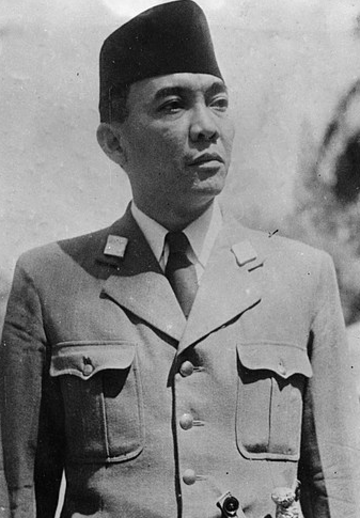Jogjakarta, 2 May 1958
To His Excellency, the President of the Republic of Indonesia
Dr. Ir. SOEKARNO
In JAKARTA
With regard to the letter from the Director of the Presidential Cabinet no. 1134/Um/58 signed by the Presidential Secretary Mr. Santosa and dated 14 April 1958 stating that H.E. the President does not want to be seen as a Prophet by the Indigenous Javanese Religion of the Republic of Indonesia (A.J.A.R.I.), we write this letter to lay out in brief an explanation that A.J.A.R.I. believes that Brother ’Karno is indeed our Prophet, as follows:
A.J.A.R.I. believes that Brother ’Karno is our Prophet because on the 17th of August, 1945, or 8th of Poso, a Friday and Legi day in the Javanese calendar year 1876, Brother ’Karno announced (proclaimed) to all the People of Indonesia that they should unite in throwing out the colonizers, such that the People of Indonesia collectively—with all social classes and groups obeying fully—were able to unite and throw out the colonizers. So, in the view of A.J.A.R.I., at that moment Brother ’Karno’s true spirit (the essence of Brother ’Karno) was possessed by the One True God (Hyang Wasesaning Tunggal) which actually made the proclamation, meaning that at that moment the One True God (Hyang Wasesaning Tunggal) entered or became one with the body of Brother ’Karno to proclaim the Independence of Our Country through the medium of Brother ’Karno. This is similar to how the sun acts through its rays of light or the sea acts through its waves. …
So beginning on the 13th of November 1950 the whole community of A.J.A.R.I. has believed that Brother ’Karno, who created the national philosophy of Pancasila, is the Prophet of A.J.A.R.I., because the meaning of ‘Prophet’ is the Highest Leader whose vision can create the foundation of a Country, such that what he created has been recognized by the whole People on the 17th of August 1945 or 8th of Poso 1876 in the Javanese calendar. And A.J.A.R.I. is always loyal to the Constitution of 1950,
Article 18: Every person has a right to freedom of religion, belief, and thought.
Article 19: Every person has a right to the freedom to hold and express ideas.
Article 43:
1. The State is founded on belief in the One True God.
2. The State guarantees the freedom of every resident to hold to their religion and perform the rituals of their religion and beliefs.
3. The authorities give equal protection to each recognized religious group and association. Giving any form of assistance by the authorities to any religious functionary and association or religious group is done on the basis of equal rights.
4. The authorities will oversee that all religious groups or associations are faithful to the laws, including written regulations.
With this, we surrender an attachment that gives a bit of the background of the emergence of the Indigenous Javanese Religion of the Republic of Indonesia (A.J.A.R.I.). Thus is our position, and if there is anything inappropriate we ask forgiveness a thousand times.
Respectfully,
The Chairman of the Indigenous Javanese Religion of the Republic of Indonesia
Jogjakarta.




